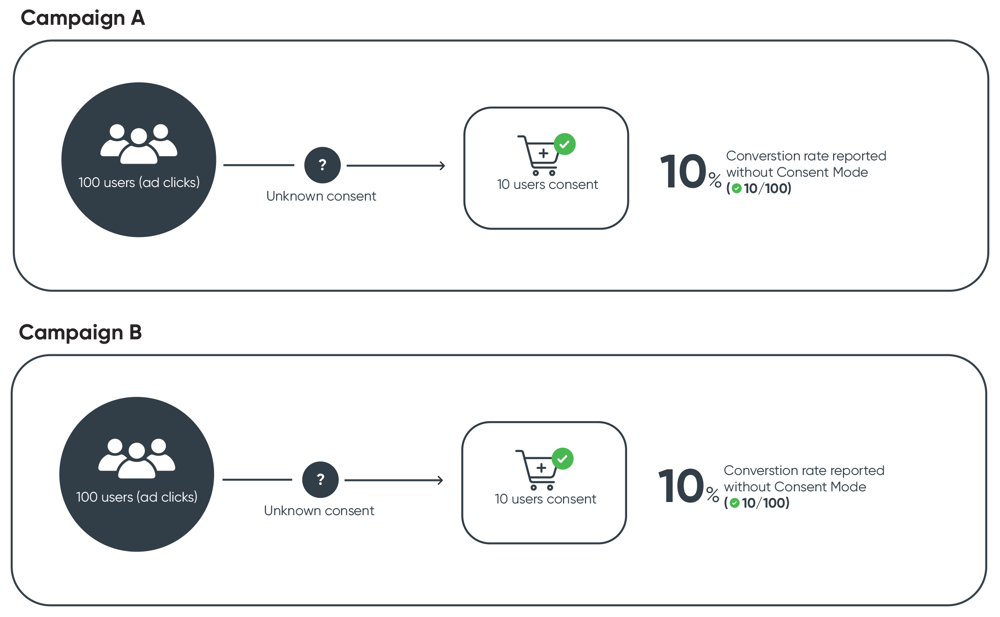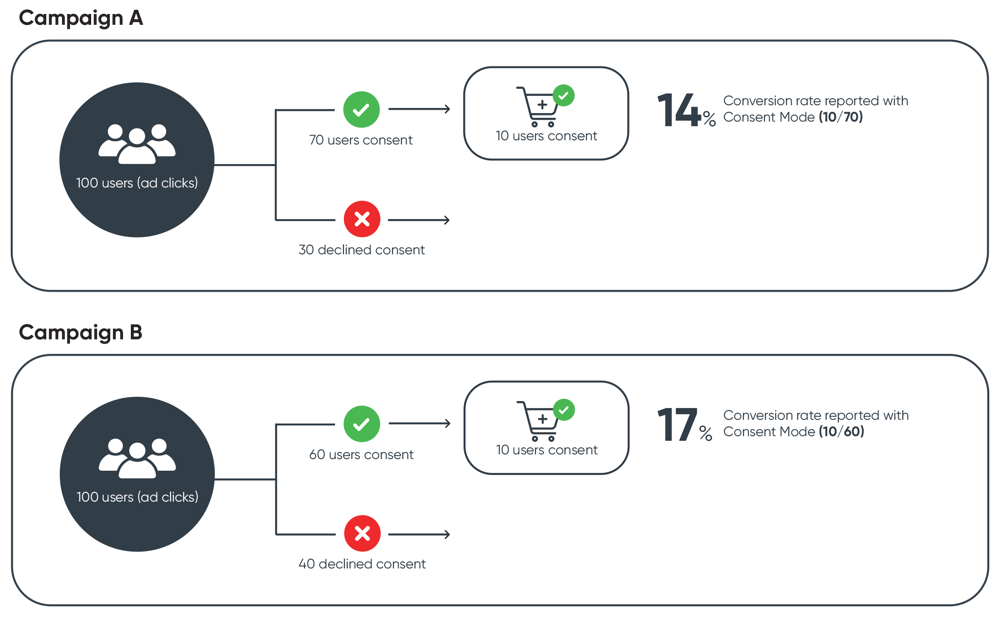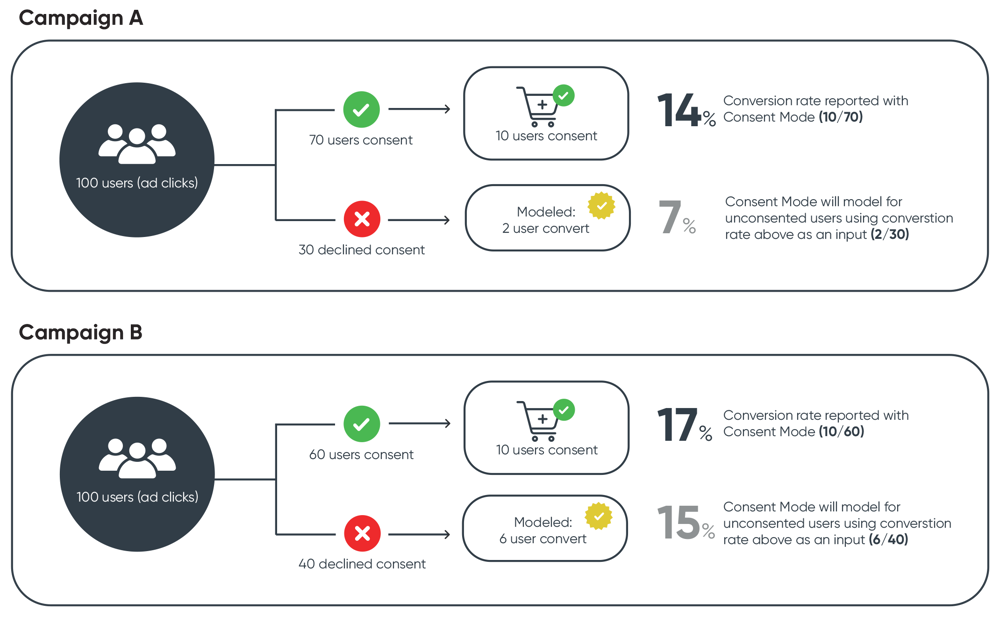The Digital Markets Act will be implemented in March 2024. What is it and what do you need to do?
Find out what this means for your business.
The new European Digital Markets Act (DMA) will come into effect in March 2024 and one purpose of the DMA is to ensure the six dominant digital platforms, known as ‘gatekeepers’ (Google, Amazon, Apple, ByteDance (TikTok), Meta, and Microsoft) are transparent in the way they collect users’ data.
The DMA is essentially an extension of GDPR, and it will bring additional consent requirements too.
Note: The UK is working on an equivalent of the DMA, called the “Digital Markets, Competition and Consumer Bill”. It is currently at Committee stage in the House of Lords.
“The Digital Markets Act is the EU’s law to make the markets in the digital sector fairer and more contestable”
- commission.europa.eu
As a reaction to this legislation, Google announced at the end of 2023 that, “Advertisers must adhere to the EU consent policy to use ad personalisation.” (This includes the UK).
To keep using measurement, ad personalisation and remarketing features on websites and mobile applications, consent must be obtained from the users.
What should you do if you’re a GA4 and Google Ads user?
Action needs to be taken, not only to comply with DMA or with Google T&Cs but to ensure that your retargeting campaigns do not suffer.
You need to do the following:
- Collect user consent using a Consent Management Platform that aligns with GDPR and can communicate the users’ choices to Google Consent Mode (Cookie Banner).
- Leverage Consent Mode to respect users’ data choice and benefit from data modelling to fill the gap in missing data.
Google will also make the Implementation of Consent Mode compulsory by March 2024 for advertisers who use Google Ads, or Google Analytics data with a Google Service.
How about the other vendors?
Meta was vocal in its criticism of the DMA, but it is taking steps to comply. It is taking the “subscription approach”: the Court of Justice of the European Union agreed that a paid subscription model can be considered as a valid form of consent by users. Effectively, paying subscribers won’t see ads; users who use the free version are deemed to consent to sharing their data and seeing ads. This model will be offered to users in the EU, EEA and Switzerland from the 1st March 2024.
Compared to Facebook, LinkedIn has been relatively quiet about the DMA. They haven't publicly opposed the legislation but haven't announced specific compliance measures either.
Back to Google Consent Mode, what is it?
Consent Mode is a tool developed by Google that communicates users’ consent choices to Google Tags (such as Google Analytics or Google Ads). These tags adjust their behaviour accordingly, and while Consent Mode is not new – with its first iteration released in 2020 – Consent Mode V2 was introduced in late November 2023 to comply with the DMA, and it now needs to be implemented by March 2024.
How does it work?
- It integrates with your Consent Management Platform (cookie banner). The selection made on the banner is communicated to Google Consent.
- Consent Mode sends a “cookieless ping” to inform the Google Tags about the visitor’s consent choices.
- Based on the signal received, the Google Tags either operate normally if the user consented, or limit or deny data collection if the user didn’t consent.
- With modelling, Google surfaces the most accurate data in your account to enable better reporting.
What are the benefits of using Consent mode?
- It makes the website owner compliant with GDPR, DMA and Google.
- It allows you to personalise your ads to users who consented.
- Consent Mode enables modeling to retrieve loss conversions due to choices made via cookie consent banners (according to Google, Consent Mode modelling recovers 65% of add click to conversion journeys lost due to unconsented users).
- When used with GTM, consent mode values can be used to trigger tags from other vendors (if the tag is managed by GTM).
Modelling gives you a more representative view of your performance so you can make efficient campaign optimisations and bidding decisions while respecting your user consent choices.
What is Consent Mode modelling?
Modeling enables Google ads to retrieve and understand the lost ad clicks to conversion journey.
Let’s say you’re running two campaigns and consent mode is not enabled...

Based on this information, we only know that for both campaigns, 100 users clicked an ad, and 10 users converted. With this limited knowledge, it is fair to assume that the ad budget should be spread equally over the two campaigns.
Let’s run the two campaigns with Consent Mode enabled...
Consent Mode allows you to understand the true consented conversion rate and the exact number of users who didn’t consent.

We now have a different story, 10 users out of 60 who consented converted from Campaign B – so the consented conversion rate of Campaign B is higher than that of Campaign A.
The data modelling part
Google uses observable, consented user journeys and uses this knowledge to model attribution paths for the unconsented journeys, therefore filling the gap for the missing data.

We now have a more accurate picture of what is really happening. The data tells us that Campaign B performs better, which could mean more budget should be allocated to Campaign B.
Does Google impose a threshold for data modelling to be implemented?
The answer to this is that Google Ads or Analytics need to have enough data to train the model.
For Google Ads, the click threshold for conversion modelling is 700 ad clicks over seven days for a domain x country grouping.
In Google Analytics 4, to be eligible for behavioral modeling, the property needs to:
- Collect at least 1,000 events per day with analytics_storage='denied' for at least 7 days.
- Have at least 1,000 daily users sending events with analytics_storage='granted' for at least 7 of the previous 28 days.
Implementation and conclusion
Implementing Consent Mode on your website depends on your current set-up. For example, which Consent Management Platform do you use? Does your site use Google Tag Manager? The main thing is with Consent Mode, privacy meets personalisation and you can adapt data collection to user consent, stay compliant, and get more accurate insights – so make sure you’re ready by March 2024.
If you have any questions related to this topic, we’re here for you, so don’t hesitate to get in touch!
References for further reading:
- Digital Market Act - https://digital-markets-act.ec.europa.eu/index_en
- Digital Markets, Competition and Consumer Bill - https://bills.parliament.uk/bills/3453
- Consent mode for websites and mobile apps - https://support.google.com/analytics/answer/9976101?hl=en, https://support.google.com/tagmanager/answer/13695607?hl=en&sjid=14814685997887569774-EU
- Behavioral modeling for consent model - https://support.google.com/analytics/answer/11161109?hl=en
- The next step toward phasing out third-party cookies in Chrome - https://developers.google.com/privacy-sandbox/blog/cookie-countdown-2024jan
- Facebook and Instagram – “Subscription for No Ads” - https://about.fb.com/news/2023/10/facebook-and-instagram-to-offer-subscription-for-no-ads-in-europe/
Read more of our insights

Deepen customer engagement, empower your marketing team and scale your business.
In today's dynamic and competitive business landscape, customer relationship management (CRM) has evolved from being a mere software solution to an indispensable strategy for sustainable growth and success. A well-planned CRM strategy can significantly impact a business in many ways, making it a vital investment for any organization.
Read more

Unleashing Creativity - Exploring the AI revolution in visual communication
We’re diving into a new era that’s going to empower creatives, fundamentally transforming the way we convey messages and craft captivating visual experiences for brands. So how will AI reshape visual communication? Here are a few thoughts.
Read more

Deinfluencing puts brand transparency into the spotlight
Discover the growing trend of 'deinfluencing' and its impact on brand transparency. As consumers demand more honesty, social media influencers are using their platforms to discourage support for certain brands. Our Paid Media Executive Scott King explains how this movement highlights the need for greater responsibility and transparency from brands and creators.
Read more

